
 by Steven D. Johnson
by Steven D. Johnson
Racine, Wisconsin
This month:
•
Wood Moves – History Lies – But You're Okay!
•
Saw Mills & Board Descriptions
•
A Little Vacation Time
Wood Moves – History Lies – But You're Okay!
Click on any picture to see a larger version.
Wood moves. Not much argument about that. And it will continue to move for as long as the wood lasts if exposed to changes in humidity outside a narrow tolerable band. For our purposes, we will refer to this type of movement as "environmentally caused." Wood also moves due to internal tensions within its cellular lattice, the most difficult movement to anticipate. We will refer to that wood movement as "tension caused."
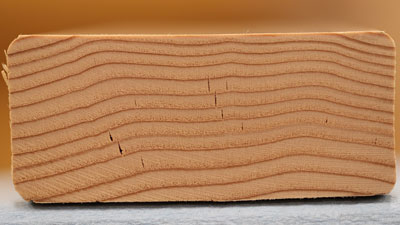
|
Figure 1 - This "flat-sawn" board is positioned with its
"bark side" up... note that the board is cupping toward the
bark side. Looking at the flat face of this board we might
call it "cathedral grain." In addition to cupping, this board will
likely develop a "bow."
|
Everyone has a fairly general concept of "environmentally caused" wood movement. As the relative humidity of the surrounding air changes, wood either absorbs or releases some of its moisture content… it is achieving an "equilibrium" state with the surrounding air. When wood is harvested, sawn into boards, and then dried (either in a kiln or naturally) the water that is lost most quickly is mostly "unbound" or "free" water. Think of it like blood in the veins. Once all that water is gone, what is left is "bound" water, or the water inside the individual cells. That "bound" water will eventually dissipate as well, until the wood reaches "equilibrium" with the moisture content of the environment in which the wood is located… the wood cells are no longer either absorbing or releasing moisture. The state at which the wood cells are "stable" and not gaining or releasing moisture is called the "Equilibrium Moisture Content" or "EMC."
EMC can be calculated and measured.
Moisture Meters
can accurately tell you the moisture content of the wood. A hygrometer can tell you the relative humidity in your environment. Charts for different wood species indicate what the EMC should be in various locales. It sounds more difficult than it is. The difficulty lies in knowing what to do with all this great information.
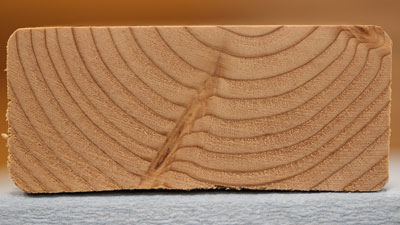
|
Figure 2 - Bark side down, note the cupping... has this been
exaggerated by the internal wood tensions caused by the
limb
position? This board is a likely candidate to develop
"twist."
|
"Tension caused" wood movement is vastly more difficult to predict. As I look out over the acre of solid hardwood trees behind my house, I see only a couple that I might select for lumber harvesting. With a prevailing southwest wind, most of my trees have grown leaning to the northeast, and the internal tensions in the wood could be substantial. Some of the trees are huge, but they grew in the relatively open and unimpeded environs of suburbia, not surrounded by other similar aged trees and being forced to climb higher and higher to compete for sunlight… therefore my trees are more "branched" and fuller, with more low limbs and less straight, long, unencumbered sections of trunk.
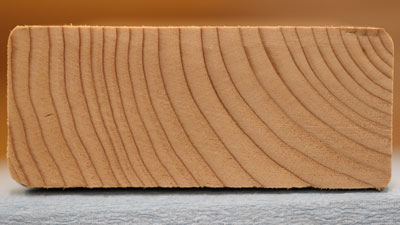
|
Figure 3 - If you ripped off the left 1/3 of this board,
would
that piece be "quarter-sawn" lumber?
As it is, this board will
likely develop a "crook."
|
Limbs strain the trunk where they grow. Add to that the strain of leaning away from the prevailing wind, the vagaries of history witnessed by irregular ring size indicating "good" and "not-so-good" growing seasons, and the resulting potential for tension inside the wood is significant. If you have done a lot of re-sawing, you have likely seen this yourself. One board yields a perfectly fine pair of boards when re-sawn, while the very next board yields two boards that bow toward or away from the middle as the internal tensions are released and the mass (therefore the resistance to movement) is reduced. That perfectly flat, square, stable two-inch thick board may yield two one-inch boards that cup, twist, bow, or warp, much to your surprise and consternation.
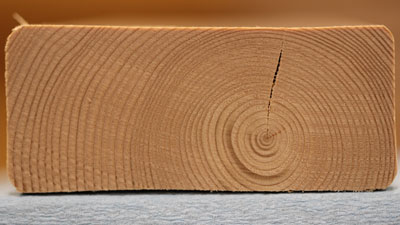
|
Figure 4 - Any chance of this piece of wood staying straight
and stable? Nada! With the unstable pith, this board could
do
anything... twist, bow, cup, or crook... or maybe even
some
combination of all those things!
|
So how did the "old masters" (whoever they are and however you define them) produce those perfectly flat and stable pieces? Why are many of the museum furniture pieces we see today as straight, true, and stable as the day they were made? Woodworkers a hundred or two-hundred years ago didn't have multi-hundred dollar moisture meters, the collective wisdom of the internet, or fancy kilns to dry their wood. Some will contend that our ancestors were simply "closer to the wood." In many instances they felled the trees themselves, then sawed it into lumber. They dried the wood naturally and eventually worked it by hand. This being "close to the wood" helped woodworkers read and understand the wood at a more intimate level, and helped them understand and compensate for wood movement as an innate, almost genetic, skill. And there is some truth to that contention, however there are other, perhaps even bigger, reasons for the stability we often see in "old master's" work.
First, the trees were better. Old growth stands of trees were tall, straight, and massive. Our ancestors knew little and cared less about conservation or what we today call "environmentalism" and they selected the tallest, straightest, most magnificent trees for making fine lumber.
Our ancestors knew from experience that lumber sawn with growth rings running vertically when viewing a board from the end (what we often call "quartersawn" lumber) would be the most stable, and they cut the boards to provide the highest quality… not the greatest "yield." "Yield" is the holy grail of sawmills today, and "waste" is the antithesis of profit. Our ancestors didn't think about "yield" and "waste"… they thought about "use." Not how many boards would a tree yield, but how do I get the "best" boards from the tree and what do I do with what is left?
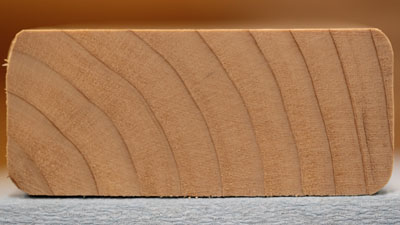
|
Figure 5 - As cheap lumber goes, this looks pretty good.
But
until we look at the other end and see if the grain
pattern is
consistent the entire length of the board, we
won't know for
sure how or how much the wood will move.
|
The finest pieces of wood were used for furniture. Less-good pieces were used as secondary lumber, hidden from view in a furniture piece. Still less-good pieces were used for constructing other things. And even less-good pieces were burned to cook their food and heat their homes.
Our ancestors left behind some beautiful work, but they also built a lot of junk. Remember the old saying, "history is written by the victors?" In this case, the furniture pieces that have survived and today reside in museums are the victors. The furniture pieces that warped, broke, rotted, or just fell apart were the losers. It would be imprudent and misleading to think that what we see in museums today is representative of the majority of furniture built during the time. No, these were the "survivor" pieces that by the good fortune of careful ownership, good tree selection, craftsmanship, or just plain dumb luck managed to stay straight and true and weather the ravages of time.
I know that sounds like heresy, but it is true. We have stunningly gorgeous works of art preserved in the desiccate caves and tombs of Egypt while the remains of a great civilization in South America were ravaged by humid jungle conditions. Hundreds of copies of America's Declaration of Independence (called the Dunlap broadsides due to having been printed in John Dunlap's Philadelphia shop) were printed on the night of July 4, 1776, but only 26 survive today. Were those 26 copies "better?" Were they printed on "better parchment?" No, they simply "survived."
So if you build new cabinets for your kitchen and all thirty doors look gorgeous the day you install them, then a few months later you notice that one or two have warped and no longer close properly or line up nicely with the others, get over it. Make a couple of new doors. Then, a hundred years from now, when someone looks at the still-straight and beautiful cabinet doors you crafted, they may well assume that you were a master craftsman, that the wood you used was carefully and correctly selected, and that you knew secrets about wood movement no longer known to modern humans… in reality, the surviving doors are simply implying an incorrect historical account of your woodworking. Get my drift? Like the doctor who buries his mistakes, make sure that only your best furniture pieces survive and you will be considered a "master" by future generations. You're okay!
(Page 1 of 3)
1
2
3
Next Page
Return to
Wood News
front page
